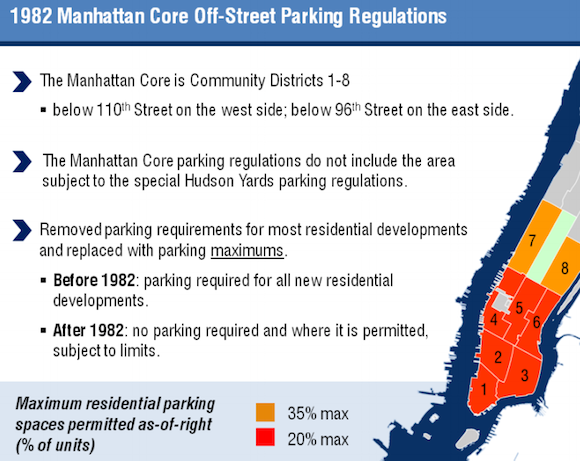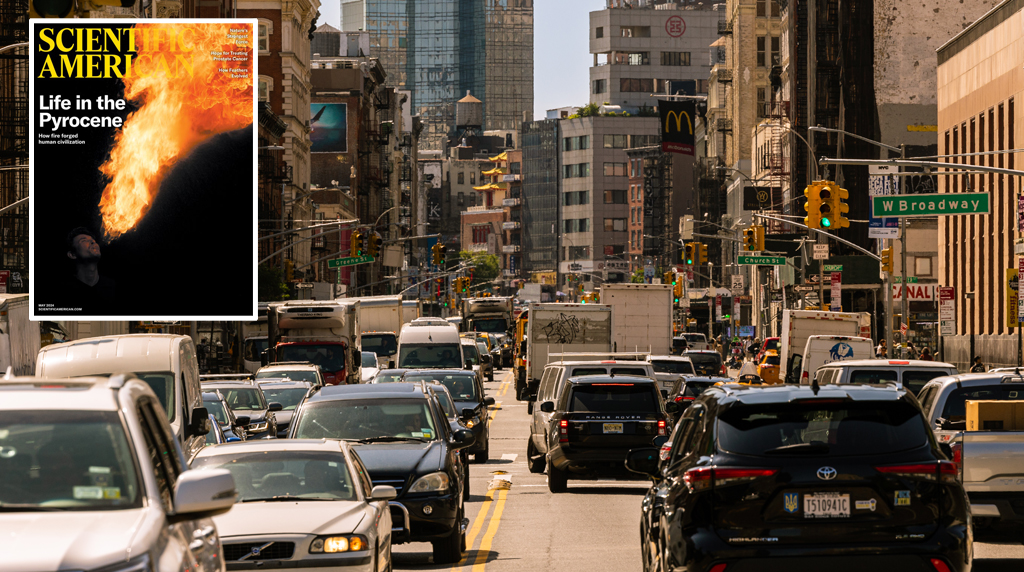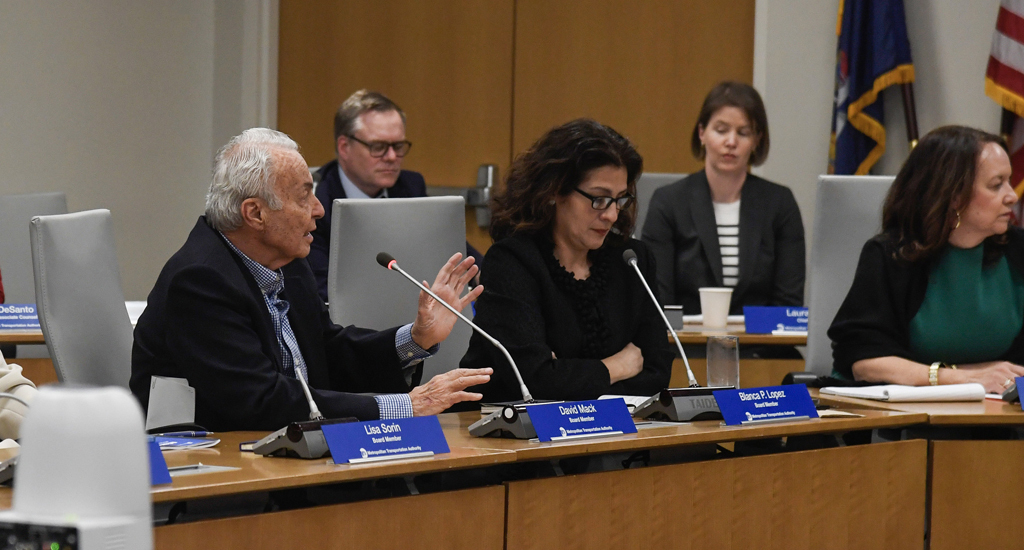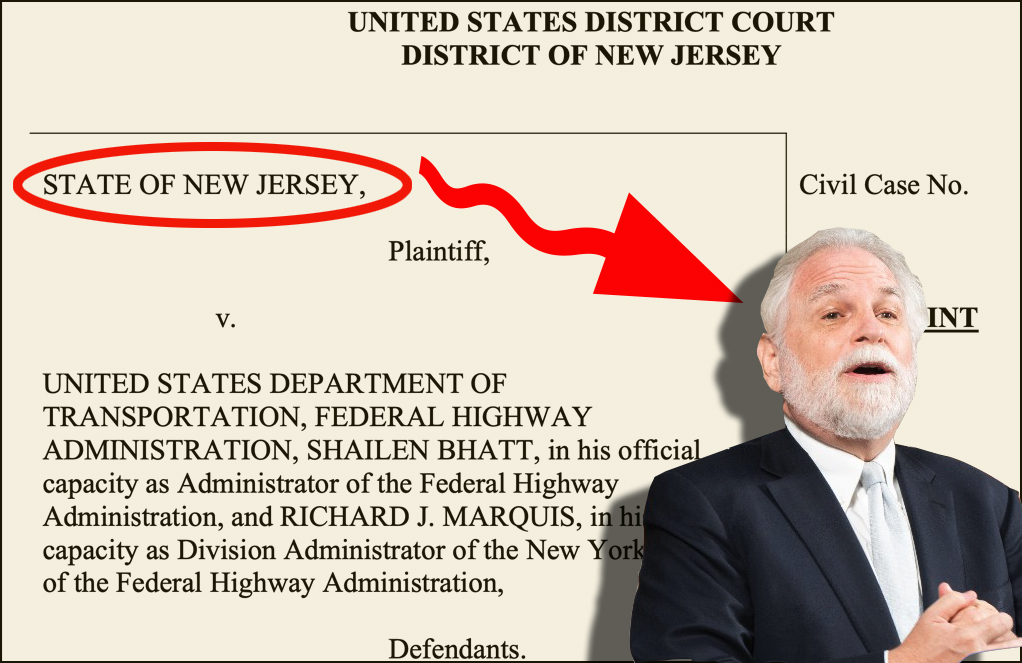DCP’s Changes to Manhattan Parking Rules: Real Reform or Trojan Horse?
5:49 PM EST on November 15, 2012

After more than three years of work, the Department of City Planning has released its proposed changes to the rules governing off-street parking in much of Manhattan. Some parking experts are calling it a necessary step toward continued reform, while neighborhood watchdogs fear that DCP's proposed changes will ultimately lead to more driving in the city’s congested center.
The “Manhattan core” area covers the area below 96th Street on the East Side and below 110th Street on the West Side. Unlike the rest of the city, where zoning requires developers to build a minimum amount of parking, developments built in the core have been subject to parking maximums since 1982.
There are several changes on the table in DCP's proposal, some of which will clearly reduce the burden imposed by parking minimums (more on those later). But the biggest change is more complicated: The city is proposing to weaken the distinction between "accessory parking" – which is intended for a building’s residents or tenants – and public parking -- available to anyone who wants to use it. Currently, developers are allowed to build accessory parking spaces up to a maximum number. If developers want to build more accessory parking than is allowed by right, or build a garage that is open to the public, they must get a special permit from the City Planning Commission.
In reality, much of the city’s accessory parking is already open to the public, because unless a building operator chooses to restrict parking to residents or tenants only, the Department of Consumer Affairs licenses garage operators without restriction on who is allowed to park in the facility.
Now, instead of working to ensure that licenses comply with the intent of the zoning law, DCP wants to change the zoning so it “reflects how parking is actually being used in the Core today.”
Calling this change “the single best thing the city could do,” professor David King of Columbia University says that he’d like to see the city completely eliminate accessory parking from the zoning code. By moving to a "shared parking” model, parking spaces are no longer reserved for specific buildings, removing the expectation that a driver should have an off-street space at the beginning and end of every trip. “It is a necessary prerequisite for any future parking reform,” he said.
Applying the shared model to accessory parking spaces could have some unwanted effects, however. “On the one hand, it's much more efficient, because idle parking spaces aren't a particularly good idea,” parking policy expert Rachel Weinberger explained. However, making more parking available to the public can lead to more driving, Weinberger added. “It has the potential to increase the parking supply.”
It’s exactly this prospect that has some parking watchdogs worried, because in Manhattan, public parking can be a major revenue generator for property owners. “If it's available to the public,” said environmental planner Dan Gutman, “then more of it will get built.”
Leaders of Community Board 4, which has seen a wave of development with lots of parking on the West Side between 14th and 59th Streets, are worried that new garages open to the public will generate more traffic in their neighborhood. The board sent a letter to Planning Commissioner Amanda Burden in July arguing that opening accessory parking to public use could violate both the court order that led to the 1982 parking limits -- compelled by the Clean Air Act -- and New York's State Implementation Plan, which includes parking policy as a strategy for compliance with the Clean Air Act.
In fact, DCP staff still wants the state Department of Environmental Conservation to remove parking policy from the list of Clean Air Act obligations. Without this legal basis for parking limits, advocates probably could not have compelled the city to build less parking in the Hudson Yards mega-development.
DCP is also proposing to change the requirements for the special permit process if a developer wants to exceed the parking cap or build a public garage. Although the planning commission currently approves four out of every five special permit requests it receives, the process itself can sometimes discourage developers from pursuing exemptions. Gutman thinks this will be less likely under the proposed rules. “There's so much flexibility in there,” Gutman said. “I think the net result will be that it will be easier to get these spaces.”
Currently, special permit requests are referred to the Department of Transportation and the Department of Environmental Protection for reports on the traffic and air quality impacts of each proposal. The proposed zoning text eliminates consultation with DOT and DEP from the special permit process.
Other changes in the proposed zoning text:
- In a positive development, buildings with parking built before the 1982 reforms will be allowed to reduce or eliminate their existing parking supply with authorization from the City Planning Commission. This is similar to a provision in the recent Downtown Brooklyn parking reforms.
- DCP's proposal would eliminate the perverse mandates to build parking in Manhattan's affordable housing projects. Instead, affordable housing would be subject to the same parking regulations as other new residential development, which are capped at 20 percent of residential units below 60th Street and 35 percent of units on the Upper East and Upper West sides. Combined with the retroactivity rule, this will allow affordable housing developments to convert existing parking supply to other uses (like housing).
- The proposed text also drops the parking maximum for retail uses from 100 spaces to 10 spaces. Although this does not eliminate the retail parking allowance entirely, as was proposed earlier by DCP, it does still encourage more pedestrian-oriented development.
- In dense commercial and manufacturing districts, commercial vehicles, car sharing vehicles, and rental cars will be allowed to occupy up to half of a parking facility’s spaces. This is higher than the allowance for lower-density districts. DCP's goal is to have more commercial vans and rental cars that make off-peak trips into Manhattan stay in Manhattan, instead of driving back and forth over river crossings.
- Currently, there are two automated garages in the Manhattan core, with more on the way. The proposed text includes standards for this type of facility, which require less space per automobile than conventional garages. DCP is also proposing that automated garages up to 40 feet above street level should be exempt from a development’s floor area ratio calculation, subject to certification by the City Planning Commission chair, providing an incentive build an automated facility.
DCP will be presenting its proposed changes to the Manhattan core parking regulations to community boards in the coming weeks, and will be at CB 4’s transportation committee tonight. The meeting begins at 6:30 p.m. at the Holland House’s Piano Room, located at 351 West 42nd Street.
Stay in touch
Sign up for our free newsletter
More from Streetsblog New York City
Deal Reached: Hochul Says ‘Sammy’s Law’ Will Pass
The bill, though imperfect, has been four years in the making.
Komanoff: A ‘Noise Tax’ Can Ground NYC Helicopters
A proposed $400 “noise tax” on “nonessential” flights is a start — and it will work.
Thursday’s Headlines: Welcome to the War on Cars, Scientific American
Our favorite story yesterday was this editorial in an unexpected place. Plus other news.
Meet the MTA Board Member and Congestion Pricing Foe Who Uses Bridges and Tunnels For Free Every Day
Mack drives over the transportation authority's bridges and tunnels thanks to a rare perk of which he is the primary beneficent.
Randy Mastro Aspires to Join Mayor’s Inner Circle of Congestion Pricing Foes
The mayor's reported pick to run the city Law Department is former deputy mayor under Rudy Giuliani and notorious foe of bike lanes and congestion pricing.




